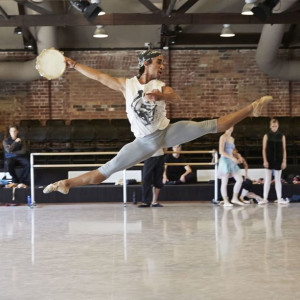Smeared eyeliner, stubbornly resisting my hurried post-performance attempts of removal, coupled with a newly acquired turtleneck jumper, was making me -- on reflection -- a giant bull’s-eye. Saturday night’s Sandringham train, departing Flinders Street Station, always displayed an unpredictable cross-section of Melbourne’s citizens, willing to engage easy targets with their loud Victorian- Bitter bathed conversation:
“Is that make-up on your face, mate?”
Oh boy, here we go. Naïvely I admitted to just finishing a performance, encouraging the loaded question: “Which performance?” Needless to say my answer (in retrospect I should have lied), Swan Lake, drew an exaggerated laugh. My interlocuter snorted the news to his drinking buddies, and they performed a ballerina music-box imitation for the carriage of trapped passengers.
I had a similar, yet dissimilar, experience in the UK. Saturday nights on West Midlands’ trains are colourful football fan affairs. Being, as I am, a magnet for unwanted attention, a seemingly crude assortment of Tottenham Hotsper supporters, sheltering their brown paper bags, plonked adjacent. Conversation inevitably led to the question – “What do you do?” – and, surprise, no condescending reaction. Coincidently his former schoolmate was a ballet dancer and he professed unexpected admiration.
Admittedly, on this occasion, I struck lucky. Yet these were not isolated events. Which brings me to a begrudging, anglophile supposition: In comparison, are the English -- particularly the men -- more comfortably associated with ballet and male dancers than us?
Billy Elliot’s fictional, yet factually inspired story, set in England’s north – of the struggle between a coal-mining dad’s stereotyped views and his ballet aspiring son – seemingly contradicts my assertion. Certainly male ballet dancers, almost universally, confront an effeminate tag. Anne Woolliams reflects in her instructive manual, Ballet Studio: An Inside View: “The Western world occasionally seems still to be wallowing in the aftermath of the decadent nineteenth century, where the male dancer was reduced to a secondary role.” She compares us to Eastern European countries where, “male dancers are esteemed no less than other performing artists such as musicians, singers and actors”. So the English are maybe not frontrunners, but the Antipodeans, I believe, are lagging even further behind.
For blokes’ down-under, ballet seems to contradict our practical and agricultural – “manly” -- mind-set. It connotes impracticality; like selling macaroons from a Rockhampton cattle station. ??? Less art form, more “camp” dalliance. Male ballet dancers and ballet become the butt of jokes, based on lazy clichés: of men wearing tutus with pointe shoes and too skinny ballerinas. Infuriating. Giving ballet a “fair go”, dressing up for the theatre: no chance, mate.
Conversely, in the UK, theatre and watching a West End show – musical, play or ballet -- is a tradition. Consequently, rarely would talk of my career induce derision. Usually an inflected: “Oh right”, followed by an educated attempt: “You guys are really fit aren’t you?” Then occasionally: “My wife and I saw that Swan Lake last week,” and sometimes: “It wasn’t bad actually.”
These cultural differences are tangibly exhibited through the varying marketing techniques used between nations. Take the UK and its most famous balletic institution, the Royal Ballet. It sells production, stars and the royal emblem first; straightforward sells, everyone knows the product.
Enticing an Aussie audience, especially the male demographic, necessitates more deception. It is a tough sell -- on a par with selling Vegemite to Americans. To encourage our stigmatised population, we align male dancers with sport and athleticism -- which is deemed a more palatable, masculine package -- and ballerinas with fashion, that way subliminally appealing to our true loves: sport and fashion.
This brings to mind an awkward photo-shoot I once had, sandwiched between Aussie cricketers Brad Haddin and Brad Hodge. We reversed roles for the camera; they held the ballerinas’ in fish-dives, I held centre, imitating a spare-wheel holding a cricket bat with the optimistic expression “I hope this looks better than it feels”. It did not.
Historically England is advantaged. Its affiliation with our continentally born art-form dates back to the 17th century, where, to quote Jennifer Homans from her book Apollo’s Angels: “Ballet was seen as a ‘frivolous Circumstance’ at best and at worst as a suspect enterprise cloaking indecent impulses and vaguely related to prostitution.” With centuries of digestion involved, men in tights and puffy jackets, like Shakespearean plays, have become a familiar diet. In comparison, Australia’s first taste was the Ballet Russes tours of the early 20th century, and we are still getting used to the flavour.
Maybe I am being too negative. Indeed dance – and male dancing -- is riding a wave of popularity in Australia. Television programs such as Glee and So you think you can dance seem to be emboldening a new generation of aspiring dancers -- notably male. Reflecting this, a recent Australian Bureau of Statistics report ranked dancing’s popularity at tenth. Yes, tenth! Just behind Rugby Union, for boys aged five to 14 (admittedly ballet was the least favoured dance). And there are numerous articles, like The Sydney Morning Herald’s, “Out of the shadows…more men in tights”, testifying to “a significant increase in the number of men taking up ballet”.
To add, Australasian ballet companies are booming. The Australian ballet recorded in its 2014 annual report an eight million dollar surplus. Queensland Ballet is selling out. And both the West Australian and New Zealand ballet companies appear very secure.
Yet, while acknowledging a recent momentum shift in popularity, I still feel like our societies’ perception of ballet is playing catch up. I admit my impressions are empirical, mainly based on collected memories and conversations --“the vibe” to quote The Castle -- from years spent as a professional dancer in both environments (13 years in Australia and five in the UK). But I am impatient for change.
C’mon Aussies, we usually beat the Brits. It is time to quickly boot those boorish stereotypes into the billabong and beyond!
-- MATTHEW LAWRENCE was a dancer with the Australian, Birmingham and Queensland ballet companies.



